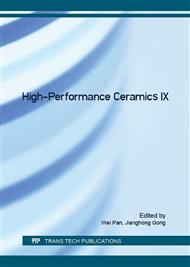p.7
p.12
p.18
p.23
p.27
p.33
p.39
p.44
p.49
Preparation of Amorphous SiOC Ceramic Powders through Precursor Polymer Pyrolysis
Abstract:
SiOC ceramic as anode material for lithium ion batteries has received extensive attention recently. In this work, polycarbosilane and polymethylhydrosiloxane were used as precursor polymers through a curing, pyrolysis and ball-milling progress to synthesize three kinds of ceramic powders with different components noted as SCO1, SCO2 and SCO3, respectively. The pyrolysis process of precursor polymers were investigated by the thermogravimetric analysis (TGA) and differential scanning calorimetry (DSC). And the effect of ball milling progress on the particle size of SiOC ceramic powders was researched. The microstructure of ceramic powders was investigated by scanning electron microscopy (SEM), phase and element composition was analyzed by X-ray diffraction (XRD) and energy dispersive spectroscopy (EDS), and the tap density of ceramic powders was measured. Results show that when the curing temperature was 190 °C and the pyrolysis temperature was 900 oC , the ceramic powders with the particle size between 70 nm-2 μm can be obtained through the ball-milling method at the milling speed of 350 r∙min-1 and ball-milling time of 25 h. The SiOC ceramic powders pyrolyzed at 900°C were amorphous, containing Si, C and O elements. The addition of polymethylhydrosiloxane can adjust contents of C and O in SiOC ceramics. The tap density of the powders was increased from 0.65g∙cm-3 to 0.76 g∙cm-3 with the addition of polymethylhydrosiloxane.
Info:
Periodical:
Pages:
27-32
Citation:
Online since:
July 2016
Authors:
Keywords:
Price:
Сopyright:
© 2016 Trans Tech Publications Ltd. All Rights Reserved
Share:
Citation:


